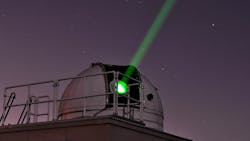Air Force reaches out to industry for electro-optical technologies to range and track orbiting satellites
KIRTLAND AIR FORCE BASE, N.M. – U.S. Air Force space experts are asking industry to develop Earth-based ranging capability to track the precise altitudes and speeds of orbiting satellites.
Officials of the Air Force Research Laboratory Directed Energy Directorate at Kirtland Air force Base, N.M., issued a broad-agency announcement (FA9451-19-S-0007) on Tuesday for the Active Sensing for Orbital Determination project.
The goal is to develop an active electro-optical ranging and characterization capability for artificial satellites in Earth orbit to facilitate rapid orbit building capabilities and relative ranging information for satellites located in close proximity.
Information from a precision ranging system also might be able to provide unique sensitivity related to slight accelerations or motion of satellite components.
The Active Sensing for Orbital Determination project is part of the Air Force's Technical Applications for Optical Space Situational Awareness (TAOS) project.
The project's first phase will examine design tradeoffs like direct detect vs heterodyne detection techniques in various sky background conditions; linear vs. Geiger-mode detectors; monostatic vs bistatic systems; and laser power vs. telescope aperture diameter trades which consider laser pulse length and AO capabilities.
The second phase of this satellite tracking project involves component testing to mature component technologies and build confidence in candidate system architectures. The third phase, not included in this effort, would be the final integration and testing of a complete system prototype.
Research should compare direct- and coherent-detection approaches; light efficiency; and efficacy in various sky background conditions.
System design should consider linear-mode vs Geiger-mode ranging detectors; laser power and other laser characteristics; aperture size; monostatic vs. bistatic; AO and tracking requirements and design; Rayleigh beacon vs Sodium beacon AO; and available components and technology readiness levels.
A wave-optics simulation model of recommended system design should confirm analytic predictions for the recommended architecture; integrate, characterize, and refine detection algorithms.
Mission-motivated concepts of operation (CONOPS) should involve queuing requirements; acquisition approach and requirements; timelines; and orbit determination for detection of closely spaced objects.
Simulation studies and model validation should consider detectors; laser beacon sources; detection algorithms; orbit determination algorithms; passive trackers; and ranging lasers. Total estimated funding is 8 million through 2022. One or more contracts may be awarded. Expected award date is June 2020.
Companies interested should upload white papers no later than 1 May 2020 to https://safe.apps.mil. Email questions or concerns to the Air Force's Ryan Coder at [email protected], or Kimerie Smith at [email protected].
More information is online at https://beta.sam.gov/opp/aa38d28ec5384b74bb1b3ef19c36a8f6/view.

John Keller | Editor-in-Chief
John Keller is the Editor-in-Chief, Military & Aerospace Electronics Magazine--provides extensive coverage and analysis of enabling electronics and optoelectronic technologies in military, space and commercial aviation applications. John has been a member of the Military & Aerospace Electronics staff since 1989 and chief editor since 1995.

